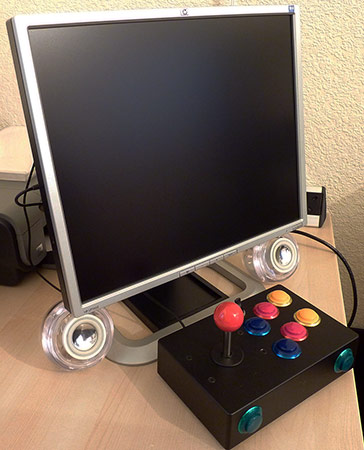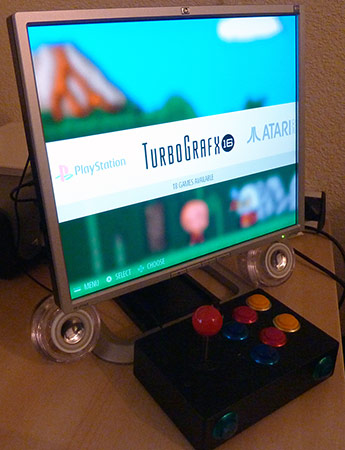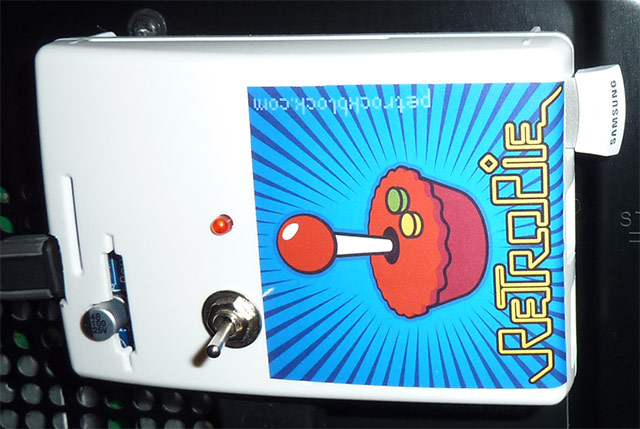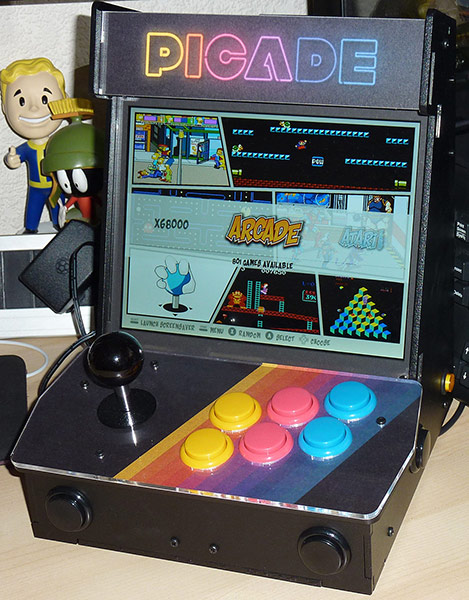

Picade!
desk top arcade machine
I am a gamer. I have been since the dawn of video games. I've watched the industry grow, boom and evolve into the corporate monster it is now. To the point that games are very different from when it all began. 3 hrs and you've completed the latest COD game. Playing with other people involves putting on headphones and listeing to homophobic 10 year old American kids smack talking everyone while playing god awful music. All the time kicking your arse because your reflexes have gone south. I believe this is a dark time in video gaming history, an all time low in fact. To the point I have sold my PS3 and Xbox360 with no intention of getting an Xbone or PS4.
Indeed I've regressed. I've dug out my old Dreamcast and Gamecube, which are IMO the last proper gamer's consoles, and it's been a revalation. Playing multiplayer games in the same room with friends. Playing simple games that are fiendish and addictive. I'm loving it. Indeed I want more, I want to go back to those days when you hit the video arcade with a pocket full of 10p pieces.
I spent a lot of time in video arcades in my formative years. I can stick a credit in Hard Driving and sit there for hours before people start to get pissed off with me (my older brother can do the same with Defender). Much like as you get older you crave 'vintage' things. I've been craving vintage arcade games. To the point that I discovered Bar-Top Arcade systems (do a search).
They generally consist of a proper box with a PC in it running MAME (Multi-Arcade Machine Emulator) and can be really very impressive. Sadly I lack the space and the funds to splash out on that. So instead I've set out to build a desk top arcade in a monitor (it's actually 'on', but you get the idea).
That's not to say this couldn't be dropped into a box at some point, it could and it might. But for now, it's all going on around the back of an old HP monitor I had surplus.
The heart of the machine is a Raspberry Pi. A tiny £29 Linux computer. On this is loaded Retropie Emulation Station. The Pi itself is powered by a USB socket on the monitor and connected to it via a HDMI-DVI adapter. Because of the way the software is configured, the whole thing can be operated on the joystick. I'll come to that soon.
Also around the back is a tiny USB amp I picked up on eBay for buttons. Power is again from a monitor USB socket. I put it in a box and am running an old pair Apple Pro speakers. All of which sounds way better than it has any right to given that whole set up cost less than a tenner.
Finally there's the stick of joy. Ye olde Hammond 1550G box containing some proper arcade machine bits from Ultracabs, who not only supply arcade machine parts, bit make cabinets for them too. To make it all work took a Raphnet USB Game12 PCB and a lot of wire. Additionally, I've dropped in an auto-fire (which you can see me flicking on and off in the video), because, quite frankly I'm not 12 any more. Vero for that HERE.
All set up it takes up no more space than a monitor and can easily be stowed away when not in use as you just unplug the stick, put the speakers on the base and stick it in the corner.
I suspect all up it owes me something in the region of £70 in parts. I really can't complain.
As to how it works, I've made a crappy clip below to demonstrate.
UPDATE: Picade has had a significant update. The Apple Pro speakers were cumbersome so some iMac speakers have been fitted to the back of the screen using another mini-amp board. The Raspberry Pi is now a Pi2. A quad core beastie that with significantly more poke, handles some of the tougher emulators with ease, where the original could creak a bit. Along with this we've migrated onto Advance MAME for the arcade emulation. This has allowed us to implement monitor rotation (something this stand accomodates) for vertical screen games. This was worth the cost of the upgrade (all of about £30 for everything) alone.
Basically it's even more awesome. We've also made a second full Picade setup for Cleggy. Joystick and all. Because we can.
ANOTHER UPDATE: A new Raspberry Pi with even more power means another update to the Picade to RetroPie 4. The extra grunt of the Pi3 means we can have a lot more fun with filters for example. The PSX emulation now doubles the resolution of 3D elements and then adds scanlines. It looks spectacular, to the point that you have to wonder why Sony didn't do something similar with it's own PSX emulation on the PS3.
It's not all been plain sailing though. We were having some stuttering problems on CD based games. This turned out to be an I/O issue when everything was on the micro SD. Splitting the ROMs onto a USB stick solved that one in the end, but it took some tracking down as to the cause as it'd not done this on previous versions.
From the hardware side there have not been as many changes. The Pi3 is now stuck to the back of my telly. I'm having to use a dual USB power lead to give it enough grunt to run, but otherwise it's much as it was. The arcade stick is still in use, though I occasionally use my Xbox gamepad also.

Not a great deal to see here really. It's a Pi with a switch!
As standard Pi's boot when you plug them in. When you shut them down, in order to get it to start again, you have to pull the plug and plug it back in again. Not very elegant for this setup. I've used a Powerblock. Which shuts the computer down correctly when you switch it off, and powers it up normally on a switch. Nice.
Another evolution of the Picade in the form of Pimeroni's Picade mini-desktop arcade machine. Coincidentally named the same thing I've been calling it since the begining and essentially exactly the same thing we did with the first Picade right at the top of the page. Made just up the road in Sheffield too, I have to wonder if I was at least inspiration to them? Well played lads regardless, I like it!
It is much smaller than I envisaged my creation would have been, but it's actually really bloody brilliant. You'd think the 8" display would be too small, but on the contrary, it's perfectly in proportion with the cab. My previous joystick I've set up as a second controller too so I can just plug in and play two player games. It's all like it was meant to be!
We're now at Retropie 4.4 and we've tweaked the build to be way more arcade biased. Where there are some console things in there, I've got most of those covered with actual hardware or the Wii now (which is running on a CRT at 240P giving just a lovely, lovely picture). I'm really happy with where this has ended up. The only deviations from the stock build are the Powerblock and a on board beefy PSU which I had surplus, so has ended up here with a view to possible future expansion.
Is this the end of the picade journey? Who knows. I've thought about lighting that marqee or possibly even getting some custom artwork done. Back in the day I was going to get my hands on a Defender machine. It was running, and just needed to be re-installed into a cab. One thing led to another and it never happened. But it might be fun to get the defender artwork made up to go on this mini cab to finally realise the dream 25ish years later.
I'll add a video demo here soon... By soon, given how slack I am at updating the site, that might be a couple of months, if at all. But I did plan to do it at the time of typing this.
Pimoroni have updated and refined the Picade kit. It's smaller, much easier to build, has a better screen and is cheaper. Now there's no excuse! Here is Mr Clegg's mk2 alongside my mk1.
So yeah, I sold my Picade mk1 and bought a Picade mk2 with 10" higher resolution screen. I also splased out on a Sanwa joystick for it with a stiffer spring because the supplied stick, though much better than it was with the initial run of the Mk2 cab, ain't as good as that.

[ back ]